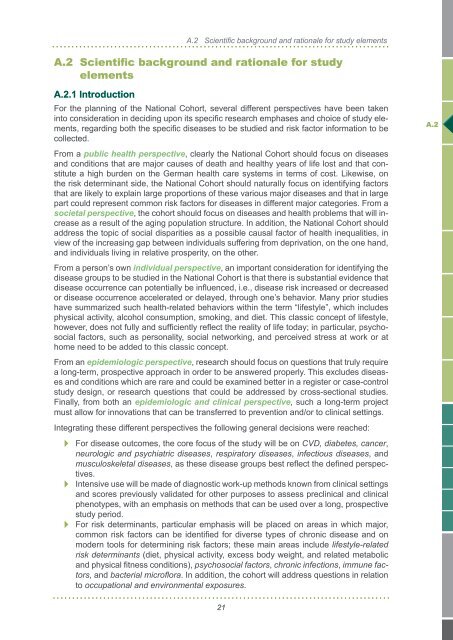Scientific Concept of the National Cohort (status ... - Nationale Kohorte
Scientific Concept of the National Cohort (status ... - Nationale Kohorte
Scientific Concept of the National Cohort (status ... - Nationale Kohorte
You also want an ePaper? Increase the reach of your titles
YUMPU automatically turns print PDFs into web optimized ePapers that Google loves.
A.2 <strong>Scientific</strong> background and rationale for study elements<br />
A.2 <strong>Scientific</strong> background and rationale for study<br />
elements<br />
A.2.1 Introduction<br />
For <strong>the</strong> planning <strong>of</strong> <strong>the</strong> <strong>National</strong> <strong>Cohort</strong>, several different perspectives have been taken<br />
into consideration in deciding upon its specific research emphases and choice <strong>of</strong> study elements,<br />
regarding both <strong>the</strong> specific diseases to be studied and risk factor information to be<br />
collected.<br />
From a public health perspective, clearly <strong>the</strong> <strong>National</strong> <strong>Cohort</strong> should focus on diseases<br />
and conditions that are major causes <strong>of</strong> death and healthy years <strong>of</strong> life lost and that constitute<br />
a high burden on <strong>the</strong> German health care systems in terms <strong>of</strong> cost. Likewise, on<br />
<strong>the</strong> risk determinant side, <strong>the</strong> <strong>National</strong> <strong>Cohort</strong> should naturally focus on identifying factors<br />
that are likely to explain large proportions <strong>of</strong> <strong>the</strong>se various major diseases and that in large<br />
part could represent common risk factors for diseases in different major categories. From a<br />
societal perspective, <strong>the</strong> cohort should focus on diseases and health problems that will increase<br />
as a result <strong>of</strong> <strong>the</strong> aging population structure. In addition, <strong>the</strong> <strong>National</strong> <strong>Cohort</strong> should<br />
address <strong>the</strong> topic <strong>of</strong> social disparities as a possible causal factor <strong>of</strong> health inequalities, in<br />
view <strong>of</strong> <strong>the</strong> increasing gap between individuals suffering from deprivation, on <strong>the</strong> one hand,<br />
and individuals living in relative prosperity, on <strong>the</strong> o<strong>the</strong>r.<br />
From a person’s own individual perspective, an important consideration for identifying <strong>the</strong><br />
disease groups to be studied in <strong>the</strong> <strong>National</strong> <strong>Cohort</strong> is that <strong>the</strong>re is substantial evidence that<br />
disease occurrence can potentially be influenced, i.e., disease risk increased or decreased<br />
or disease occurrence accelerated or delayed, through one’s behavior. Many prior studies<br />
have summarized such health-related behaviors within <strong>the</strong> term “lifestyle”, which includes<br />
physical activity, alcohol consumption, smoking, and diet. This classic concept <strong>of</strong> lifestyle,<br />
however, does not fully and sufficiently reflect <strong>the</strong> reality <strong>of</strong> life today; in particular, psychosocial<br />
factors, such as personality, social networking, and perceived stress at work or at<br />
home need to be added to this classic concept.<br />
From an epidemiologic perspective, research should focus on questions that truly require<br />
a long-term, prospective approach in order to be answered properly. This excludes diseases<br />
and conditions which are rare and could be examined better in a register or case-control<br />
study design, or research questions that could be addressed by cross-sectional studies.<br />
Finally, from both an epidemiologic and clinical perspective, such a long-term project<br />
must allow for innovations that can be transferred to prevention and/or to clinical settings.<br />
Integrating <strong>the</strong>se different perspectives <strong>the</strong> following general decisions were reached:<br />
� For disease outcomes, <strong>the</strong> core focus <strong>of</strong> <strong>the</strong> study will be on CVD, diabetes, cancer,<br />
neurologic and psychiatric diseases, respiratory diseases, infectious diseases, and<br />
musculoskeletal diseases, as <strong>the</strong>se disease groups best reflect <strong>the</strong> defined perspectives.<br />
� Intensive use will be made <strong>of</strong> diagnostic work-up methods known from clinical settings<br />
and scores previously validated for o<strong>the</strong>r purposes to assess preclinical and clinical<br />
phenotypes, with an emphasis on methods that can be used over a long, prospective<br />
study period.<br />
� For risk determinants, particular emphasis will be placed on areas in which major,<br />
common risk factors can be identified for diverse types <strong>of</strong> chronic disease and on<br />
modern tools for determining risk factors; <strong>the</strong>se main areas include lifestyle-related<br />
risk determinants (diet, physical activity, excess body weight, and related metabolic<br />
and physical fitness conditions), psychosocial factors, chronic infections, immune factors,<br />
and bacterial micr<strong>of</strong>lora. In addition, <strong>the</strong> cohort will address questions in relation<br />
to occupational and environmental exposures.<br />
21<br />
A.2



